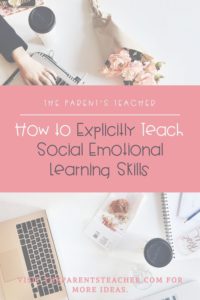It is a misconception that only those children showing a specific lack in communication skills need to learn social emotional learning skills. In our present life, research is showing more reasons to explicitly teach and integrate social skills into our daily routine. There is a difference in telling a child what to do versus explicitly teaching the skill. Morning meetings, family meetings, community circle (the name isn’t nearly as important as the concept) are an expanding and successful way to teach social emotional learning skills.
These learned social skills transfer to the child’s lifestyle now and in the future. Explicitly practicing and understanding these skills lead to better decision making, caring and thinking for oneself and for others. When people truly understand their own and others’ emotions, they build a foundation for controlling these emotions better.
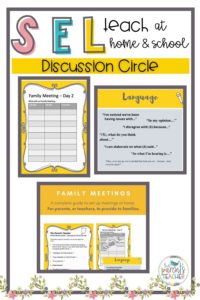
What is Social Emotional Learning?
Social Emotional Learning (SEL) refers to people understanding and managing their emotions. This includes the way we empathize with others, build healthy relationships, set goals, and make good decisions.
The five components of social emotional learning include: self-awareness, self-management, responsible decision making, social awareness, and relationship skills.
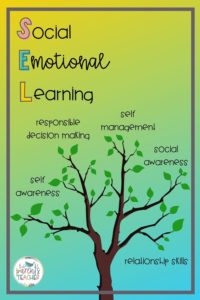
Self-Awareness: understanding one’s emotions and values as well as one’s strengths and challenges.
Self-Management: managing emotions and actions to achieve one’s goals.
Responsible Decision Making: making ethical, constructive choices about personal and social behavior.
Social Awareness: interacting, understanding, and showing empathy for others.
Relationship Skills: forming positive relationships, working in teams, dealing effectively with conflict.
Download my free guide to 5 Steps to Teaching Social Emotional Learning here.
How a Student-Teacher Relationship Connects to Academic and Social Progress
Back when I was in school, we had one-off sessions on peer pressure, bullying, and similar topics with our counselor. However, the concept of everyday social talk between student and teacher was simply not a thing. Our teachers were there to teach us the curriculum and help resolve problems as they came about. Nowadays schools and districts that truly understand the importance of explicitly teaching social emotional learning, have taken the student-teacher relationship to a new level.
Recent research notes that student-teacher interactions within the classroom impact both students’ educational performance and social wellbeing. Therefore, schools that recognize this are starting to implement these teachings into their daily schedules. Even beyond counselor sessions, teachers are addressing these topics within their own classrooms. And they’re not waiting until problems come out into the open, but rather, are discussing these topics before they ever become an issue.
How to Teach SEL at School
So, what’s the best way to teach SEL skills at school? I personally saw that teaching SEL skills during morning meeting impacted my classroom environment tremendously. Students who initially reacted through behaviors such as knocking down desks across the classroom and throwing fists at other students eventually started to open up to their own peers by expressing their emotions. They used the cooldown corner to write a letter (or, in my classroom, wrote a rap song) to help compile their mixture of emotions. They found their own feelings in a fictional book character, and they started to get more comfortable talking about topics such as bullying and confidence.

Besides just these emotional skills, they started to gain more social skills. These skills were taught in the classroom, but transferred outside of our 4 classroom walls. With daily morning meetings around SEL, I noticed my students making eye contact when speaking to someone. They improved their communication skills by having more intellectual conversations and discussions; instead of ‘yes’ and ‘no’ responses, they were challenged to back up their responses with “because…”. They seldomly interrupted other students, but rather, learned to wait for a pause before following up with their own thoughts. Academically, this allowed us to think deeper into topics of even history and mathematics. Socially, these students were learning skills that would go far beyond their elementary school years.
How Incorporating Social Emotional Learning Skills First Started for Us
Getting to this point took some pre work. It all started with morning meetings. These meetings were structured, and not at the same time. We set expectations and boundaries to make this a comfortable space. I had a plan of what we could discuss sometimes, but most of the time, students found this as an open space to talk. We learned how to become aware of our emotions, express them in a safe way and then discussed and took action to address them.
It didn’t just stop there, during reading workshop, we read books and discussed the characters. We talked about them deeply and empathized with them. The next morning, we may have even brought that character into our discussion to help recognize how someone might be feeling in real life. We transferred something we learned in the book and brought it to real life situations. We discussed a variety of topics; you can download a list of some of my topics for free here.
How a Parent-Teacher Relationship Connects to Academic and Social Progress
To really hold a continuous impact on the future of today’s children, it doesn’t start and end with a student-teacher relationship. We also have to take it down to a parent-teacher relationship and a parent-child relationship. We could hold an even greater impact on children when parents and teachers work together to teach social skills both at school and at home.
With a parent-teacher relationship, the child will see and hear more consistent social skills and better grasp the skills. Even after the child has moved into another classroom, school or district, the parent can continue to grow these learned skills. When the child hears about a topic another student brought up during morning meeting, they can openly discuss this with either the teacher or the parent. Now the child has more options of who to discuss with and has two safe methods of communication. Plus, the child gets to see these skills in varying environments.
A continuous collaboration between parents and teachers should foster children’s story and their voice. This should help build the child’s place in the community. This combined effort should display great models for the children, both socially and academically.
What a Parent-Teacher Collaboration can Look Like
So how can parents and teachers communicate? You will be waiting a while if you leave it to parent teacher conferences. The communication needs to come from both parties, at least on a weekly basis. Good news, this does not mean you have to find a time and place to meet every week in your busy schedules. A simple email or newsletter providing a general idea of the topics discussed that week would work great!
At home, families could incorporate a spinoff of morning meetings. Aside from dinner table talk and asking how the child’s day was at school, there is much more families can begin to easily incorporate with some additional effort. During the ‘family meeting’ time, caregivers could take the role of a facilitator. Both children and adults could feel safe and open to bring in topics of concern or interest. The established meeting time should not be to punish or blame, but to have open discussions, and learn together. You can learn more about activities for social emotional learning and starting family meetings in your home here.
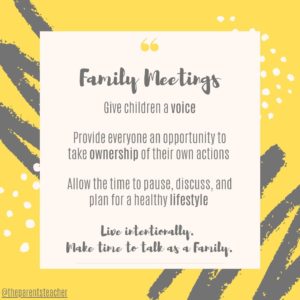
Social Emotional Learning – Who, When, Where?!
Who: We can start teaching these skills and holding these meetings as soon as children are capable of grasping the smallest concepts, like sharing their toys.
When: The more meetings there are, the more learning that can happen. At the same time, we want this to be an enjoyable learning period and don’t want to overkill. The recommended starting point would be 3 times per week and then could be more or less based on what works for your family. It is important to remember that teaching in the moment of a heated mind, when the scenario just took place, does not count as an inclusive meeting time.
Where – School, home, within any community events. The more people collaborating on this effort, the more results we should see.
Why Teaching Social Emotional Learning Skills Explicitly is so Important
Integrating lessons throughout the day with your children likely comes out naturally. If your child screams at the dinner table, you naturally teach them why this is not appropriate. You model what good dinner etiquette looks like. But to transfer this skill of understanding and performing etiquette behavior not just at the dinner table, but in various settings, you will get better results when you explicitly take the time to teach and discuss this behavior outside of when the situation happens. The key word is “skill”. The child does not learn to do one thing at one specific time but rather translates this ‘skill’ into everyday life, for the rest of his or her life.
Academically, self aware children are more likely to understand where they need help. In a comfortable environment, these children are more likely to have the confidence to ask an adult, or their peers for help.
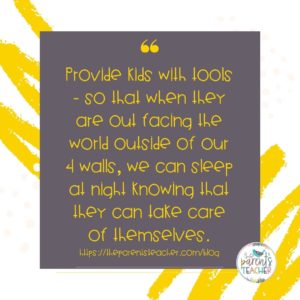
Check these two scenarios:
Scenario One:
|Child yells at the dinner table. Parent tells the child to stop yelling and show good manners.
Scenario Two:
|Child yells at the dinner table. Parent mentions that during dinner, proper manners includes chewing with our mouth closed and speaking in a quieter voice. At the family meeting that night, the topic is ‘manners’. The family discusses what manners looks, feels, and sounds like in different places; i.e. at the grocery store, the library, at a park, restaurant, dinnertime at home.
Breaking Down the Scenarios:
In scenario one, the problem may have been temporarily fixed. Parent and child may have continued to be angry or upset after the instance. The child may or may not have known the meaning of ‘good manners’, now trying to guess on their own. The next time the family has dinner, it is likely that the same inappropriate behavior may be seen again. The cycle continues – inappropriate behavior – scolding – new environment – inappropriate behavior…
*Temporarily fixed, at this one dinner only.*
In scenario two, the parent is calm and explicitly explained what needed to happen at the dinner table. The situation should have been temporarily fixed without any shaming of the child. Later, the topic of manners was brought up during the family meeting time. There was no mention of what happened at the dinner table, to avoid blame and shame. The family discussed manners at varying environments. Now, the child does not only understand manners and expectations for the dinner table, but understands what behavior is expected at different places too. S/he understands that different environments call for different behaviors.
By the end of this discussion, the child should connect what behavior s/he had at dinner that night. Then, s/he is more capable to translate how this behavior could look differently in the future. When visiting different places, the family can now efficiently discuss what ‘manners’ at the place will look, feel, and sound like. Eventually, the child will be able to observe the surroundings, and make appropriate choices themselves. They should no longer require parents to teach them manners for every place they will visit in the world. S/he has now built this as a learned social skill.
*New skill learned, fixed now and in the future, in numerous situations.*
Key Takeaways of Social Emotional Learning
As shown in the scenarios above, explicitly teaching social emotional skills is so important. When schools and families work together, we should notice great impact in our youth both socially, and academically. This impact will take place now, and in the future.
We need parents and teachers, schools and families to collaborate and teach social emotional learning skills to all children.
